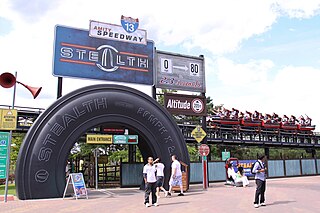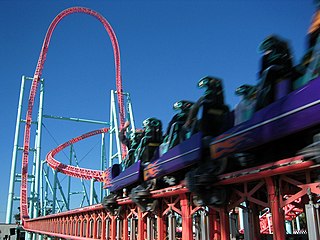
A roller coaster, or rollercoaster, is a type of amusement ride that employs a form of elevated railroad track designed with tight turns, steep slopes, and sometimes inversions. Passengers ride along the track in open cars, and the rides are often found in amusement parks and theme parks around the world. LaMarcus Adna Thompson obtained one of the first known patents for a roller coaster design in 1885, related to the Switchback Railway that opened a year earlier at Coney Island. The track in a coaster design does not necessarily have to be a complete circuit, as shuttle roller coasters demonstrate. Most roller coasters have multiple cars in which passengers sit and are restrained. Two or more cars hooked together are called a train. Some roller coasters, notably Wild Mouse roller coasters, run with single cars.

Top Thrill Dragster was a steel accelerator roller coaster located at Cedar Point in Sandusky, Ohio, United States. Manufactured by Intamin, it opened in 2003 as the tallest roller coaster in the world and the first full-circuit roller coaster to exceed 400 feet (120 m) in height. Its height record was later surpassed by Kingda Ka at Six Flags Great Adventure in 2005.

Kingda Ka is a launched roller coaster located at Six Flags Great Adventure in Jackson, New Jersey. Designed by Werner Stengel, Kingda Ka is an Accelerator Coaster model from Intamin that opened as the tallest and fastest roller coaster in the world on May 21, 2005. It is also the world's only operating strata coaster, a full-circuit roller coaster taller than 400 feet (120 m); the now-closed Top Thrill Dragster was the first and previously held both records.

Intamin Amusement Rides is a design and manufacturing company in Schaan, Liechtenstein. It is best known for creating thrill rides and roller coasters worldwide. The Intamin brand name is a syllabic abbreviation for "international amusement installations". The company has offices throughout the world, including three in Europe, three in Asia, and two in the United States.
A brake run on a roller coaster is any section of track meant to slow or stop a roller coaster train. Brake runs may be located anywhere along the circuit of a coaster and may be designed to bring the train to a complete halt or to simply adjust the train's speed. Contrary to some belief, the vast majority of roller coasters do not have any form of braking on the train itself, but rather forms of braking that exist on track sections. One notable exception is the Scenic Railway roller coaster, which relies on an operator to manually control the speed of the train.

The launched roller coaster is a modern form of roller coaster. A launched coaster initiates a ride with high amounts of acceleration via one or a series of linear induction motors (LIM), linear synchronous motors (LSM), catapults, tires, chains, or other mechanisms employing hydraulic or pneumatic power, along a launch track. This mode of acceleration powers many of the fastest rollercoasters in the world.

Werner Stengel is a German roller coaster designer and engineer. Stengel is the founder of Stengel Engineering, also known as Ingenieurbüro Stengel GmbH.

Do-Dodonpa (ド・ドドンパ), formerly known as Dodonpa (ドドンパ), is a steel roller coaster located at Fuji-Q Highland in Fujiyoshida, Yamanashi, Japan. Manufactured by S&S – Sansei Technologies, the launched coaster uses compressed air to propel its trains. It opened on 21 December 2001 as the fastest roller coaster in the world with the fastest acceleration, reaching a top speed of 172 km/h (106.9 mph) in 1.8 seconds. The fastest speed record was previously held by Superman: The Escape at Six Flags Magic Mountain and Tower of Terror at Dreamworld, both of which accelerated to 160.9 km/h (100 mph) in 7 seconds. The ride was refurbished in 2017, removing the top hat element in favor of a vertical loop and increasing its speed and acceleration to 180 km/h (111.8 mph) in 1.6 seconds. Steel fabrication was provided by Intermountain Lift, Inc. In 2021, the ride was closed down indefinitely after multiple complaints of the ride breaking riders' bones were raised.

An on-ride camera is a camera mounted alongside the track of a roller coaster, log flume or other thrill ride that automatically photographs all of the riders on each passing vehicle. They are often mounted at the most intense or fastest part of the ride, resulting in humorously distorted expressions due to fear or wind resistance. The pictures are then available for viewing and purchase as a souvenir.

The launch track is the section of a launched roller coaster in which the train is accelerated to its full speed in a matter of seconds. A launch track is always straight and is usually banked upwards slightly, so that a train would roll backwards to the station in the event of a loss of power.

Stealth is a launched roller coaster in the Amity area of Thorpe Park located in Surrey, England. Built and designed by Intamin of Switzerland for £12 million, the Accelerator Coaster model opened in 2006, a year after another Accelerator, Rita, opened at sister park Alton Towers. It reaches a height of 62.5 metres (205 ft) and accelerates from 0 to 80 mph (129 km/h) in 1.9 seconds. It is the fastest roller coaster in the UK, and the second tallest after the Big One at Blackpool Pleasure Beach.

Hypersonic XLC was a roller coaster located at Kings Dominion in Doswell, Virginia. Hypersonic was built by S&S Worldwide, a company specializing in air-powered rides, and was the first compressed air launch coaster in the world. Hypersonic was S&S Worldwide's actual prototype for an air-launched coaster, called Thrust Air 2000.

Steel Dragon 2000 is a steel roller coaster located at Nagashima Spa Land amusement park in Mie Prefecture, Japan.

Xcelerator is a steel launched roller coaster at Knott's Berry Farm in Buena Park, California. It was Intamin's first hydraulically launched coaster, while also the fourth Intamin installation at Knott's, alongside Sky Cabin, Calico River Rapids and Perilous Plunge.

An Accelerator Coaster is a hydraulically launched roller coaster model from Intamin. The model usually consists of a long, straight launch track, a top hat tower element, and magnetic brakes that smoothly stop the train without making contact. The technology was developed by Intamin engineers as an alternative to electromagnetic launch systems, such as the Linear Induction Motor (LIM) and Linear Synchronous Motor (LSM), that are found on earlier launched roller coasters like the Flight of Fear and The Joker's Jinx. Unlike the earlier linear induction motors, the Accelerator Coaster's launch system exhibits constant acceleration and is capable of reaching greater speeds.
Roller coaster elements are the individual parts of roller coaster design and operation, such as a track, hill, loop, or turn. Variations in normal track movement that add thrill or excitement to the ride are often called "thrill elements".

Invertigo is the name of an inverted shuttle roller coaster model developed and manufactured by Dutch company Vekoma. Four roller coasters based on this model were built, with the first installation opening in 1997 as HangOver at Liseberg amusement park located in Sweden. Three of the four are still in operation. Invertigo is designed as an inverted variation of their traditional Boomerang model, which first appeared in 1984. Invertigo's seat configuration is also a departure from its predecessor, in that riders sit back-to-back, resulting in all rows facing one another with the exception of the first and last.

The Swarm is a steel roller coaster located at Thorpe Park in the United Kingdom. The Swarm was the world's second Wing Coaster model designed by Swiss roller coaster manufacturer Bolliger & Mabillard and the only one located in the United Kingdom. Construction commenced in May 2011, and the coaster opened on 15 March 2012. From 2013 until 2015, the last two rows of each train faced backwards, while the first five rows faced forward. This was restored to the original for safety reasons in 2016, with all riders facing forward once again.

Red Force is a steel launched roller coaster located at Ferrari Land within PortAventura World in Salou, Catalonia, Spain. The ride was manufactured by Lichtenstein based Swiss manufacturer Intamin and opened on 7 April 2017. With a height of 112 metres (367 ft) and a maximum speed of 180 kilometres per hour (112 mph), Red Force is the tallest and fastest roller coaster in Europe as of 2022.

















